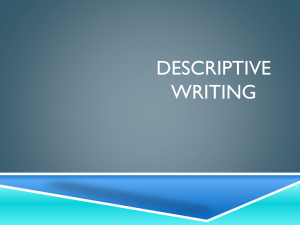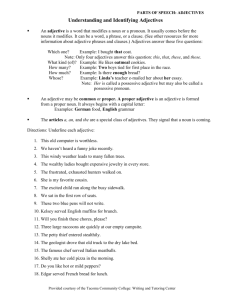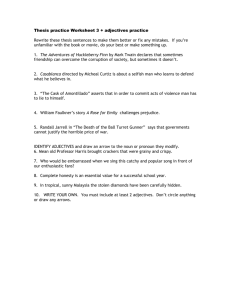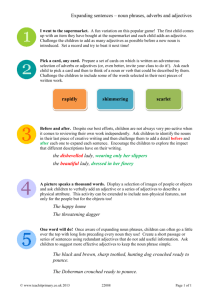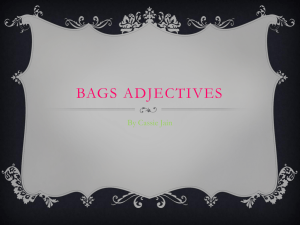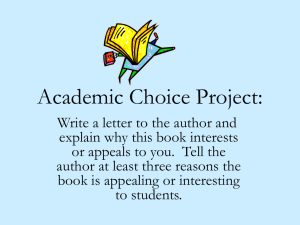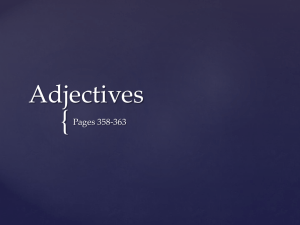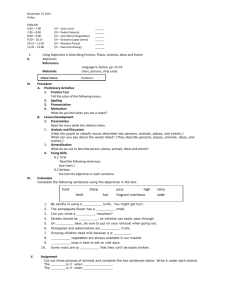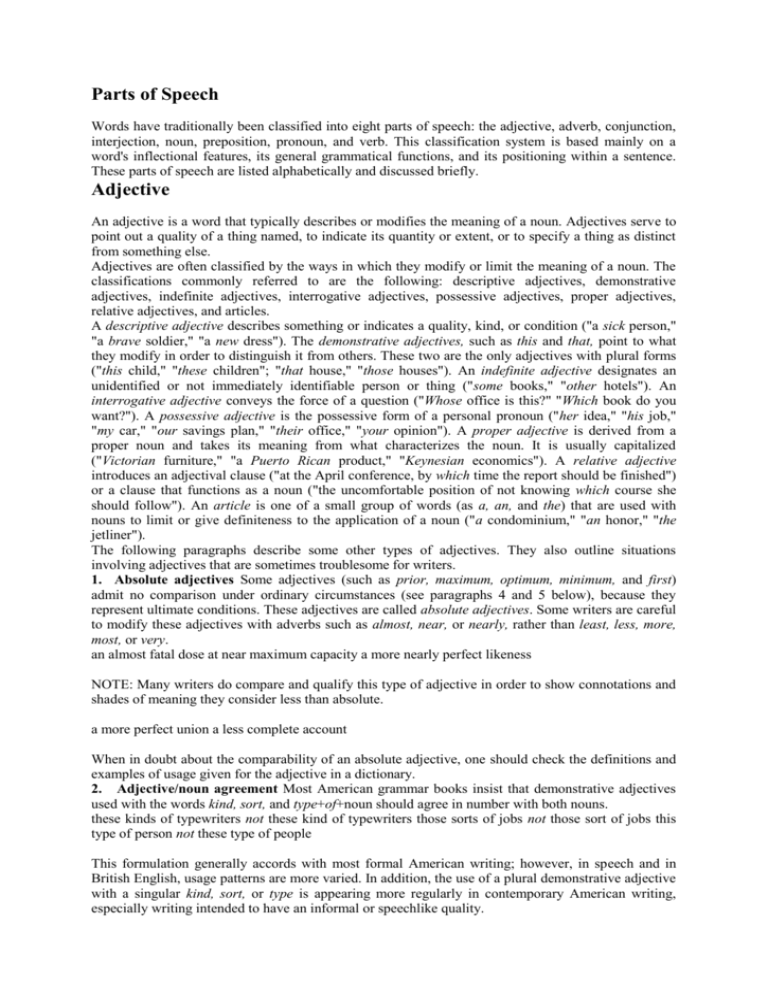
Parts of Speech
Words have traditionally been classified into eight parts of speech: the adjective, adverb, conjunction,
interjection, noun, preposition, pronoun, and verb. This classification system is based mainly on a
word's inflectional features, its general grammatical functions, and its positioning within a sentence.
These parts of speech are listed alphabetically and discussed briefly.
Adjective
An adjective is a word that typically describes or modifies the meaning of a noun. Adjectives serve to
point out a quality of a thing named, to indicate its quantity or extent, or to specify a thing as distinct
from something else.
Adjectives are often classified by the ways in which they modify or limit the meaning of a noun. The
classifications commonly referred to are the following: descriptive adjectives, demonstrative
adjectives, indefinite adjectives, interrogative adjectives, possessive adjectives, proper adjectives,
relative adjectives, and articles.
A descriptive adjective describes something or indicates a quality, kind, or condition ("a sick person,"
"a brave soldier," "a new dress"). The demonstrative adjectives, such as this and that, point to what
they modify in order to distinguish it from others. These two are the only adjectives with plural forms
("this child," "these children"; "that house," "those houses"). An indefinite adjective designates an
unidentified or not immediately identifiable person or thing ("some books," "other hotels"). An
interrogative adjective conveys the force of a question ("Whose office is this?" "Which book do you
want?"). A possessive adjective is the possessive form of a personal pronoun ("her idea," "his job,"
"my car," "our savings plan," "their office," "your opinion"). A proper adjective is derived from a
proper noun and takes its meaning from what characterizes the noun. It is usually capitalized
("Victorian furniture," "a Puerto Rican product," "Keynesian economics"). A relative adjective
introduces an adjectival clause ("at the April conference, by which time the report should be finished")
or a clause that functions as a noun ("the uncomfortable position of not knowing which course she
should follow"). An article is one of a small group of words (as a, an, and the) that are used with
nouns to limit or give definiteness to the application of a noun ("a condominium," "an honor," "the
jetliner").
The following paragraphs describe some other types of adjectives. They also outline situations
involving adjectives that are sometimes troublesome for writers.
1. Absolute adjectives Some adjectives (such as prior, maximum, optimum, minimum, and first)
admit no comparison under ordinary circumstances (see paragraphs 4 and 5 below), because they
represent ultimate conditions. These adjectives are called absolute adjectives. Some writers are careful
to modify these adjectives with adverbs such as almost, near, or nearly, rather than least, less, more,
most, or very.
an almost fatal dose at near maximum capacity a more nearly perfect likeness
NOTE: Many writers do compare and qualify this type of adjective in order to show connotations and
shades of meaning they consider less than absolute.
a more perfect union a less complete account
When in doubt about the comparability of an absolute adjective, one should check the definitions and
examples of usage given for the adjective in a dictionary.
2. Adjective/noun agreement Most American grammar books insist that demonstrative adjectives
used with the words kind, sort, and type+of+noun should agree in number with both nouns.
these kinds of typewriters not these kind of typewriters those sorts of jobs not those sort of jobs this
type of person not these type of people
This formulation generally accords with most formal American writing; however, in speech and in
British English, usage patterns are more varied. In addition, the use of a plural demonstrative adjective
with a singular kind, sort, or type is appearing more regularly in contemporary American writing,
especially writing intended to have an informal or speechlike quality.
3. Compared with adverbs Both adjectives and adverbs describe or modify other words; however,
adjectives can only modify nouns, while adverbs can modify verbs, adverbs, and adjectives. For more
on the differences between adjectives and adverbs, see paragraph 14 below and paragraphs 4-6 under
Adverb in this section.
4. Comparison of adjectives The main structural feature of an adjective is its ability to indicate
degrees of comparison (positive, comparative, superlative) by addition of suffixal endings -er/-est to
the base word, by addition of more/most or less/least before the base word, or by use of irregular
forms.
5. The comparative degree is used to show that the thing being modified has more (or less) of a
particular quality than the one or ones to which it is being compared. The superlative degree is used to
show that the thing being modified has the most (or least) of a quality out of all of the ones to which it
is being compared. The superlative degree is most commonly used when there are more than two
things being compared.
comparative prices that were higher than those at other stores a better report than our last one the more
expensive of the two methods superlative the highest prices in the area the best report so far the most
expensive of the three methods
6. In general, the comparatives and superlatives of one-syllable adjectives are formed by adding -er/est to the base word. The comparatives and superlatives of adjectives with more than two syllables are
formed by adding more and most or less and least before the base word. The comparatives and
superlatives of two-syllable adjectives are variously formed by adding -er/ -est to the base word or
using more and most or less and least before the base word. When in doubt about the inflection of a
particular adjective, one should consult a dictionary. 1Parts of Speech
Words have traditionally been classified into eight parts of speech: the adjective, adverb, conjunction,
interjection, noun, preposition, pronoun, and verb. This classification system is based mainly on a
word's inflectional features, its general grammatical functions, and its positioning within a sentence.
These parts of speech are listed alphabetically and discussed briefly.
Adjective
An adjective is a word that typically describes or modifies the meaning of a noun. Adjectives serve to
point out a quality of a thing named, to indicate its quantity or extent, or to specify a thing as distinct
from something else.
Adjectives are often classified by the ways in which they modify or limit the meaning of a noun. The
classifications commonly referred to are the following: descriptive adjectives, demonstrative
adjectives, indefinite adjectives, interrogative adjectives, possessive adjectives, proper adjectives,
relative adjectives, and articles.
A descriptive adjective describes something or indicates a quality, kind, or condition ("a sick person,"
"a brave soldier," "a new dress"). The demonstrative adjectives, such as this and that, point to what
they modify in order to distinguish it from others. These two are the only adjectives with plural forms
("this child," "these children"; "that house," "those houses"). An indefinite adjective designates an
unidentified or not immediately identifiable person or thing ("some books," "other hotels"). An
interrogative adjective conveys the force of a question ("Whose office is this?" "Which book do you
want?"). A possessive adjective is the possessive form of a personal pronoun ("her idea," "his job,"
"my car," "our savings plan," "their office," "your opinion"). A proper adjective is derived from a
proper noun and takes its meaning from what characterizes the noun. It is usually capitalized
("Victorian furniture," "a Puerto Rican product," "Keynesian economics"). A relative adjective
introduces an adjectival clause ("at the April conference, by which time the report should be finished")
or a clause that functions as a noun ("the uncomfortable position of not knowing which course she
should follow"). An article is one of a small group of words (as a, an, and the) that are used with
nouns to limit or give definiteness to the application of a noun ("a condominium," "an honor," "the
jetliner").
1Excerpted from The Complete Reference Collection. Copyright © 1994, 1995, 1996, 1997
The Learning Company, Inc. All Rights Reserved.
The following paragraphs describe some other types of adjectives. They also outline situations
involving adjectives that are sometimes troublesome for writers.
1. Absolute adjectives Some adjectives (such as prior, maximum, optimum, minimum, and first)
admit no comparison under ordinary circumstances (see paragraphs 4 and 5 below), because they
represent ultimate conditions. These adjectives are called absolute adjectives. Some writers are careful
to modify these adjectives with adverbs such as almost, near, or nearly, rather than least, less, more,
most, or very.
an almost fatal dose at near maximum capacity a more nearly perfect likeness
NOTE: Many writers do compare and qualify this type of adjective in order to show connotations and
shades of meaning they consider less than absolute.
a more perfect union a less complete account
When in doubt about the comparability of an absolute adjective, one should check the definitions and
examples of usage given for the adjective in a dictionary.
2. Adjective/noun agreement Most American grammar books insist that demonstrative adjectives
used with the words kind, sort, and type+of+noun should agree in number with both nouns.
these kinds of typewriters not these kind of typewriters those sorts of jobs not those sort of jobs this
type of person not these type of people
This formulation generally accords with most formal American writing; however, in speech and in
British English, usage patterns are more varied. In addition, the use of a plural demonstrative adjective
with a singular kind, sort, or type is appearing more regularly in contemporary American writing,
especially writing intended to have an informal or speechlike quality.
3. Compared with adverbs Both adjectives and adverbs describe or modify other words; however,
adjectives can only modify nouns, while adverbs can modify verbs, adverbs, and adjectives. For more
on the differences between adjectives and adverbs, see paragraph 14 below and paragraphs 4-6 under
Adverb in this section.
4. Comparison of adjectives The main structural feature of an adjective is its ability to indicate
degrees of comparison (positive, comparative, superlative) by addition of suffixal endings -er/-est to
the base word, by addition of more/most or less/least before the base word, or by use of irregular
forms.
5. The comparative degree is used to show that the thing being modified has more (or less) of a
particular quality than the one or ones to which it is being compared. The superlative degree is used to
show that the thing being modified has the most (or least) of a quality out of all of the ones to which it
is being compared. The superlative degree is most commonly used when there are more than two
things being compared.
comparative prices that were higher than those at other stores a better report than our last one the more
expensive of the two methods superlative the highest prices in the area the best report so far the most
expensive of the three methods
6. In general, the comparatives and superlatives of one-syllable adjectives are formed by adding -er/est to the base word. The comparatives and superlatives of adjectives with more than two syllables are
formed by adding more and most or less and least before the base word. The comparatives and
superlatives of two-syllable adjectives are variously formed by adding -er/ -est to the base word or
using more and most or less and least before the base word. When in doubt about the inflection of a
particular adjective, one should consult a dictionary. 2
2Excerpted from The Complete Reference Collection. Copyright © 1994, 1995, 1996, 1997
The Learning Company, Inc. All Rights Reserved.

